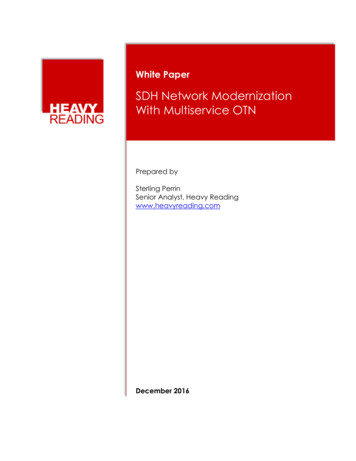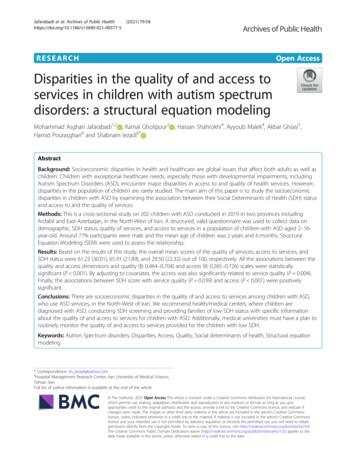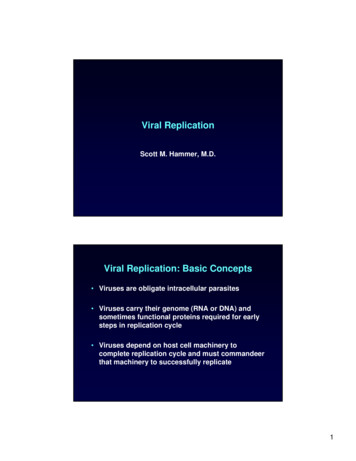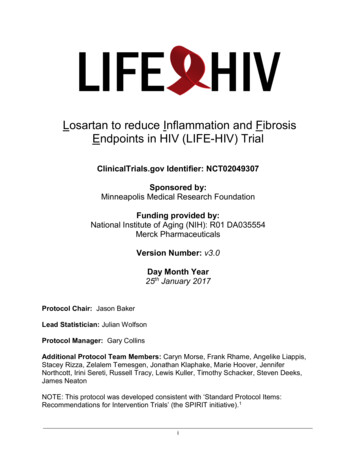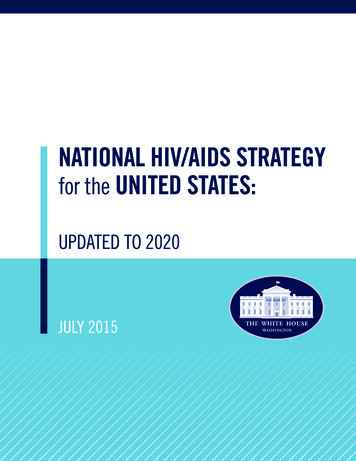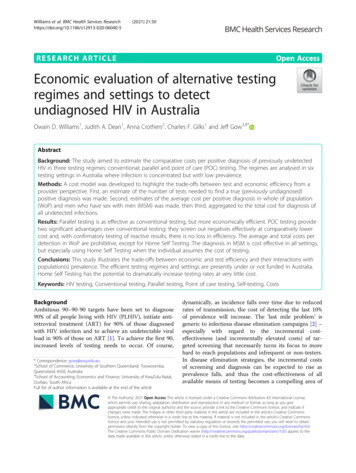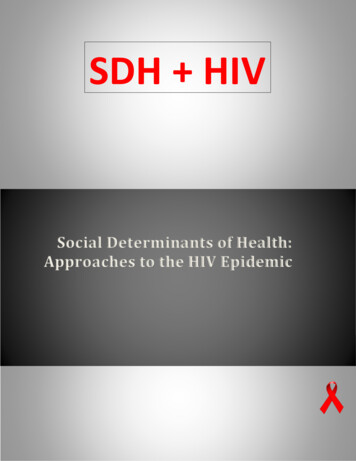
Transcription
SDH HIVSocial Determinants of Health:Approaches to the HIV Epidemic
Social Determinants of Health: Approaches to the HIV EpidemicNotice to ReadersThis document provides an overview of Social Determinants of Health (SDH) andapproaches for reducing HIV-related disparities and their collective impact on vulnerablepopulations. Strategies in this toolkit can be used to increase awareness and directprevention initiatives. These examples are provided for illustrative purposes and do notconstitute endorsement.Links to organizations found in this document are provided solely as a service to thereader. These links do not constitute an endorsement of these organizations or theirprograms, and none should be inferred. The Texas HIV Syndicate is not responsible forthe content of the individual organization sites listed in this document.The Social Determinants of Health: Approaches to the HIV Epidemic Toolkit was prepared byThe Texas HIV Syndicate: Public Awareness Priority Group with Stan Baker, ArianniBecerra, Nike Blue, Alex Byrd, Jackie Bzostek, Jeanett Deas-Calhoun, Ana Colin-Hernandez,Tom Cassady, Charlene Doria-Ortiz, Herman Finley, Nell Gaither, Helen Turner-Goldenberg,Gregg Gunter, Lionel Hillard, Ashley Innes, Marsha Jones, Markelse, Jordan, Robyn Koch,Sara Mendez, Shawna Stewart, Steven Vargas, and John Waller in association with theTexas Department of State Health Services.DOCUMENT CREATED FEBRUARY 2016Page 1 of 20
Social Determinants of Health: Approaches to the HIV EpidemicTABLE OF CONTENTS1) Introduction2) What are Social Determinants of Health3) Why address Social Determinants of Health4) How to address Social Determinants of Health5) Who should address Social Determinants of Health6) How to identify what Social Determinants of Health impact yourcommunity7) Raising awareness using social media for Social Determinants ofHealth8) Funding strategies9) Evaluation10) WebinarsDOCUMENT CREATED FEBRUARY 2016Page 2 of 20
Social Determinants of Health: Approaches to the HIV Epidemic1.IntroductionPurpose and Intended Target Audience of the ToolkitThe purpose of the Texas HIV Syndicate is to reduce HIV infections in Texas by identifyingstrategies to enhance and expand work already being done across the spectrum of HIVprevention and treatment. Texas HIV Syndicate priority groups develop resources toadvance the identified strategies across the state.The Social Determinants of Health: Approaches to the HIV Epidemic Toolkit (Toolkit) is aunique resource. Rather than solely addressing communities themselves, it was developedat a state level for individuals and organizations working with and through communities.The Toolkit is an information source which will be available to interested parties across thestate. Social Determinants of Health (SDH) are defined in the toolkit and information isgiven on raising awareness (through social media) about the role SDH play in the spread ofHIV and HIV-related disparities. The Toolkit consolidates multiple sources of informationinto one easily accessible electronic location.Toolkit UseWhile many organizations across the State of Texas have begun to address SDH in theirown communities, this Toolkit is an informative guide of available resources to supplementand complement existing efforts. The Toolkit is not prescriptive. It outlines processes thatcan be referenced, as needed, for use to meet individual program needs.DOCUMENT CREATED FEBRUARY 2016Page 3 of 20
Social Determinants of Health: Approaches to the HIV Epidemic2.What are Social Determinants of HealthHealthyPeople.gov states that SDH are “conditions in the environments in which people areborn, live, learn, work, play, worship, and age that affect a wide range of health, functioning,and quality-of-life outcomes and risks. Resources that enhance quality of life can have asignificant influence on population health outcomes.” 1HealthyPeople.gov also notes that “our health is influenced in part by social determinantssuch as access to social and economic opportunities; resources and support available in ourhomes, neighborhoods, and communities; quality of our schooling; safety of ourworkplaces; cleanliness of our water, food, and air; and the nature of our social interactionsand relationships.”2The website provides the following examples of SDH: Availability of resources to meet daily needs (e.g., safe housing & local food markets)Access to educational, economic, and job opportunitiesAccess to health care servicesQuality of education and job trainingAvailability of community-based resources in support of community living andopportunities for recreational and leisure-time activitiesTransportation optionsPublic safetySocial supportSocial norms and attitudes (e.g., discrimination, racism, & distrust of government)Exposure to crime, violence, and social disorder (e.g., presence of trash & lack ofcooperation in a community)Socioeconomic conditions (e.g., concentrated poverty & accompanying stressfulconditions)Residential segregationLanguage and literacyAccess to mass media and emerging technologies (e.g., cell phones, Internet,& socialmedia)Culture31(Healthy People. Gov, 2015)(Healthy People 2020, 2015)3(Healthy People 2020, 2015)2DOCUMENT CREATED FEBRUARY 2016Page 4 of 20
Social Determinants of Health: Approaches to the HIV EpidemicAdditional SDH ResourcesHealthy People erview.aspx?topicid 39Centers for Disease Control andPrevention: Frequently cWorld Health Organizationwho.int/social determinants/en/Centers for Disease Control andPreventioncdc.gov/socialdeterminants/National Partnership for Action to EndHealth Disparitiesminorityhealth.hhs.gov/npa/U.S. Department of Health and HumanServices Office of Minority Healthminorityhealth.hhs.gov/The Robert Wood Johnson Foundationrwjf.orgNational Association of County andCity Health Officialsnaccho.org/topics/justice/(Contains: Trainings, web based courses, &healthy equity tools)Equity, social determinants and publichealth programmesEditors Erik Blas and Anand SivasankaraKurup. WHO Press, World HealthOrganization, 20 Avenue Appia, 1211 Geneva27, Switzerland.Closing the gap in a generation: Healthequity through action on the socialdeterminants of 63970 563703 eng.pdfFinal report of the Commission on SocialDeterminants of Health. Geneva, 2008, WorldHealth Organization.DOCUMENT CREATED FEBRUARY 2016Page 5 of 20
Social Determinants of Health: Approaches to the HIV EpidemicSDH Resources ContinuedData Set Directory of SocialDeterminants of Health at the LocalLevelcdc.gov/dhdsp/docs/data set directory.pdfHillemeier, M., Lynch, J., Harper, S., Casper, M.,Data Set Directory of Social Determinants ofHealth at the Local Level. Atlanta: U.S.Department of Health and Human Services,Centers for Disease Control and Prevention;2004.Promoting Health Equity: A Resource toHelp Communities Address SocialDeterminants of iesprogram/tools/pdf/SDOH-workbook.pdfBrennan Ramirez LK, Baker EA, Metzler M.Promoting Health Equity: A Resource to HelpCommunities Address Social Determinants ofHealth. Atlanta: U.S. Department of Health andHuman Services, Centers for Disease Controland Prevention; 2008.DOCUMENT CREATED FEBRUARY 2016Page 6 of 20
Social Determinants of Health: Approaches to the HIV Epidemic3.Why Address Social Determinants of HealthAddressing social factors is critical in the quest to eliminate health disparities andunderstand the relationship between underlying conditions and individual choice. In orderto improve health, we need to focus on addressing the characteristics of communities.The following links provide information & justification regarding the need to address SDH.Improving the Health of All Americans by Focusing On Communities4This two page document by Robert Wood Johnson Foundation Commission to Build aHealthier America explains that in order to improve health we need to focus on improvingthe characteristics of communities.Social Determinants of Health Solid Facts5This report by WHO contains the following SDH topics: The social gradientStressEarly lifeSocial exclusionWork unemploymentSocial supportAddictionFoodTransportAddressing Social Determinants of Health6The 2008 Consultation Meeting Report from the National Center for HIV/AIDS, ViralHepatitis, STD, and TB Prevention (NCHHSTP) provides examples of opportunities andrecommendations of future directions regarding SDH in the areas of public health policy,data systems, agency partnerships, capacity building, prevention research, and orts/2013/rwjf406483euro.who.int/ data/assets/pdf nts/docs/final SDHConsultation ForWeb 061109.pdf 7(Prevention, 2009)5DOCUMENT CREATED FEBRUARY 2016Page 7 of 20
Social Determinants of Health: Approaches to the HIV EpidemicEstablishing a Holistic Framework to Reduce Inequities in HIV, Viral Hepatitis, STDs, andTuberculosis in the United StatesThis is an NCHHSTP White Paper on Social Determinants of Health, 2010.Social Determinants of HealthThis is an article by Community Health Improvement Partners (CHIP). CHIP draws from thematerials published by Phil Rabinowitz and his colleagues at the University of KansasCommunity Tool Box (CTB) and provides a brief overview of the what, why, who, when andhow of addressing the social determinants of health (CBT, 2010).DOCUMENT CREATED FEBRUARY 2016Page 8 of 20
Social Determinants of Health: Approaches to the HIV Epidemic4.How to Address Social Determinants of HealthA New Way to Talk about Social Determinants of HealthThis article from the Robert Wood Johnson Foundation (RWJF) provides guidance on howto develop messaging around SDH. It includes best practices in language, word choice, useof support data, and us of pictures to tell your stories.8 RWJF shares the following methodsfor talking about Social Determinants of Health. “These proxy statements can replace theSDH descriptor and help people understand the concept more clearly.Six Ways to Talk About Social Determinants of Health1. Health starts, long before illness, in our homes, schools and jobs.2. All Americans should have the opportunity to make the choices that allow them to live along, healthy life, regardless of their income, education or ethnic background.3. Your neighborhood or job shouldn’t be hazardous to your health.4. Your opportunity for health starts long before you need medical care.5. Health begins where we live, learn, work, and play.6. The opportunity for health begins in our families, neighborhoods, schools, and jobs.”9FROM THEORY TO ACTION: APPLYING SOCIAL DETERMINANTS OF HEALTH TO PUBLICHEALTH PRACTICE10This article written by Hazel Dean, Kim Williams, and Kevin Fenton seeks to illustrate howpublic health professionals can address SDH using a variety of public health activities thatpromote health equity among the populations most disproportionately impacted byinfectious and chronic diseases.8(2010 Robert Wood Johnson Foundation, 2015)(2010 Robert Wood Johnson Foundation, 2015)10(Hazel D. Dean, 2013 Supplement 3, Volume 128)9DOCUMENT CREATED FEBRUARY 2016Page 9 of 20
Social Determinants of Health: Approaches to the HIV Epidemic5.Who Should Address Social Determinants of HealthEveryone involved in health-related program development must consider health issues inthe context of SDH. Those affected by specific health issues, as well as those addressingthose issues, should know as much as possible about its context and history, as well as whoin their community might be able to address SDH.“The University of Kansas Community Tool Box advocates for participatory approaches toplanning and, in this case, for a participatory approach to analysis and intervention as well.The presence of representatives of groups affected by the issue will ensure that everyoneknows its full context and history.”11 Those who should be involved include: Those directly affected by, or at risk for, a particular health condition or communitydevelopment issue. Policy makers, legislators, officials, or others who can influence the issue. Human services staff, administrators, and others (such as police officers, teachers, andcoalition members) who are responsible for dealing with the various issues. Local figures, including advocates, clergy, and others, in the community to whompeople turn for support. Members of groups that may be asked to change, sacrifice, or take action in order toaddress the issue. Employers, landlords and other property owners, health and humanservice workers, police, and teachers might all fall into this category.12Community Tool BoxThis website contains a section discussing social determinants of health from theperspective of what, why, who, when and how.11(KU Work Group for Community Health and Development, 2015 Chapter 17, Section 5: Addressing SocialDeterminants of Health and Development)12(KU Work Group for Community Health and Development, 2015 Chapter 17, Section 5: Addressing SocialDeterminants of Health and Development)DOCUMENT CREATED FEBRUARY 2016Page 10 of 20
Social Determinants of Health: Approaches to the HIV EpidemicPromoting Health Equity: A Resource to Help Communities Address Social Determinants ofHealthThis workbook by the Center for Disease Control and Prevention is for public healthpractitioners and partners interested in addressing SDH and provides a fundamentalperspective on who should address SDH. Section 1 of the workbook titled “Creating YourPartnership to Address Social Determinants of Health” makes the following key point:“It is essential to build partnerships to address social determinants of health because no onegroup, be it health care providers, public health practitioners, or community members, canaccomplish the many tasks required for changing social, economic, and environmentalconditions that impact health.”13Additional ResourcesClosing the gap in a generation: Healthequity through action on the socialdeterminants of O IER CSDH 08.1 eng.pdf2008 WHO Commission on Social Determinantsof Health: Final report/Executive summaryACTION: SDHactionsdh.orgWebsite houses SDH information and providesa platform for SDH discussion.Tackling social determinants of healththrough community based initiativesbmj.com/content/333/7573/854.full?sid b04d836a-e1c7-4927-8581-dcadc861af95Article by M. Assai, S. Siddiqi, and S. Watts,provided by the British Medical Journal. BMJ,vol. 333, 21 October, 2006.PDF format13(Brennan Ramirez LK, 2015)DOCUMENT CREATED FEBRUARY 2016Page 11 of 20
Social Determinants of Health: Approaches to the HIV Epidemic6.How to Identify Which Social Determinants of HealthImpact Your CommunityCommunity assessments can and should be more than just gathering and analyzing data.They can also be a basis for creating change. A community-based needs assessment canhelp provide a snapshot of families in the service area and their economic wellbeing,educational status, health and welfare. Recognizing and identifying community strengthsand weaknesses can influence strategic planning and decision-making.Identifying Community Assets and ResourcesThis approach puts a focus on community assets and strengths. Community assets andstrengths can be used to meet community needs.14Developing a Plan for Assessing Local Needs and ResourcesThis website describes why you should assess needs and resources and why you shoulddevelop an assessment plan.Strengths, Weaknesses, Opportunities, and Threats (SWOT) AnalysisA SWOT analysis can offer helpful perspectives at any stage of an effort. It can be used to: Explore possibilities for new efforts or solutions to problems. Assist in the decision making process of determining the best path for yourinitiative, by identifying opportunities and threats to success. Determine where change is possible. When at a juncture or turning point, aninventory of your strengths and weaknesses can reveal priorities and possibilities. Adjust and refine plans mid-course. A new opportunity might open wider avenues,while a new threat could close a path that once existed.1514(KU Work Group for Community Health and Development, 2015 Chapter 3, Section 8: Identifying CommunityAssets and Resources)15(KU Work Group for Community Health and Development., 2015 Chapter 3, Section 14: SWOT Analysis:Strengths, Weaknesses, Opportunities, and Threats)DOCUMENT CREATED FEBRUARY 2016Page 12 of 20
Social Determinants of Health: Approaches to the HIV EpidemicAdditional SDH ResourcesAddressing Social Determinants ofHealthPractical Playbook website contains tips,strategies, and other resources.Mind Tools onmindtools.com/pages/article/newTMC 05.htmOverview of SWOTCommunity Tool Boxdescriptions, tools, & examples of mainCommunity needs Community Needs Assessment Tool Kit.pdfCommunity assessment toolsembed.chphealthmt.org/images/CommAssessTools .pdfHealth Impact Assessment (HIA)generic screening toolapho.org.uk/resource/item.aspx?RID 44898Health Impact Assessment SP5.pdf?AspxAutoDetectCookieSupport 1Why and how to collect -information/mainThis section talks about hard data: where toget it, how to use it, and its limitations.2-1-1 Texas: Finding Help in Texas211texas.orgResources by zip code Housing, Shelter, FoodAssistance, etc.2015 HIV Handbookaidseducation.org/materials/A Guide for HIV and AIDS services in NorthTexasDOCUMENT CREATED FEBRUARY 2016Page 13 of 20
Social Determinants of Health: Approaches to the HIV Epidemic7. Raising Awareness using Social Media for SocialDeterminants of HealthMessage Design Strategies to Raise Public Awareness of Social Determinants of Health andPopulation Health DisparitiesThis article reviews three message strategies that could be used to raise awareness of SDHand health disparities: message framing, narratives, and visual imagery.16Implementing a Social Marketing EffortSome of the information included in this tool kit: What is social marketing Who can do social marketing Why is social marketing important Stages of a successful social marketing effort Conducting a social marketing campaign Collecting information about the problem Understanding the issue Conducting focus groups, interviews, public forums and listening sessions17How To: Start an Awareness Campaign about Your CauseThis website contains tips on how to start an awareness campaign.16(Niederdeppe, 2008)(KU Work Group for Community Health and Development., 2015 Toolkits Section 13: Implementing a SocialMarketing Effort)17DOCUMENT CREATED FEBRUARY 2016Page 14 of 20
Social Determinants of Health: Approaches to the HIV EpidemicTypes of CampaignsServiceAn example of a service approach could be an organizer convincing neighborhood religiousinstitutions to put cots in their basements for the homelessEducationAn example of an educational approach could be researching causes of homelessness andeducating the community on this social issue.Self-HelpAn example of helping others to help themselves could be to hold workshops for homelesspeople that enabled them to gain new knowledge, skills, and employment.AdvocacyAn example of an advocacy approach could be lobbying for more homeless shelters andfood programs. When advocating for change those affected may not necessarily be involvedwith the effort.Direct ActionAn example of involving groups of people to take action for change could be organizing arally protesting against the criminalization of homelessness and the dehumanizing policiestoward those living without homes.Types of Social Media Campaigns1818 Photo campaigns Blog Entries Design campaigns Video campaigns Mixed dia-campaigns/DOCUMENT CREATED FEBRUARY 2016Page 15 of 20
Social Determinants of Health: Approaches to the HIV EpidemicAdditional Social Media ResourcesOnline Fundraising ghttypesofsocialmediafundraisingcampaignsPolicy Tool for Social Mediapolicytool.netSocial media policy outlines guidelines forcommunicating online. This tool providesa policy that can be customized for yourorganization.HIV Prevention Goes Social Part IISocial Media Strategy, Policy, &Monitoring evention-Goes-Social-Workbook-Final.pdfHIV Prevention Goes Social UsingSocial Media to Create, Connect, andCome evention-Goes-Social-Workbook-Final.pdfThe National Minority AIDS Council nmac.org/publications/HIV Goes Social and other resourcesDOCUMENT CREATED FEBRUARY 2016Page 16 of 20
Social Determinants of Health: Approaches to the HIV Epidemic8. Funding Strategies10 Ways to Start a Fund for Social Good OnlineThis website Mashable.com provides a list and description of online tools to help bringawareness to and raise funds for a campaign.Top 10 Crowdfunding SitesCrowd funding is the process of collecting funds for a wide variety of purposes through acollective approach by numerous participants. This website provides a list of sites andimportant information to know.The following websites announce available grant opportunitiesJanssen Therapeutics Grants &Contributionsjanssentherapeutics-grants.comViiv Healthcare Grantsviivhealthcare.comBristol Myers Squibb /DOCUMENT CREATED FEBRUARY 2016Page 17 of 20
Social Determinants of Health: Approaches to the HIV Epidemic9. Evaluating Social MediaHealth Communicator’s Social Media ToolkitThis toolkit by CDC’s Electronic Media Branch includes a Social Media EvaluationWorksheet starting on page 50, in addition to links to other helpful resources.A Tip-a-Day by and for EvaluatorsThis website by the American Evaluation Association offers a blog that includes daily postsof all things related to evaluation.Nonprofit Social Media Decision GuideIdealware provides a free download to their Nonprofit Social Media Decision Guide. Theguide walks through a five-step process for:1. Understanding Social Media2. Defining Your Goals and Audience3. Evaluating Specific Tools4. Choosing Tools to Meet Your Goals5. Creating Your Social Media StrategyAdditional Evaluation ResourcesEvaluating your Social Media your-social-media-programResources for Evaluating Social valuating-social-media/Using HootSuite to Monitor Evaluation Trends aea365.org/blog/jayne-corso-onand Conversations on Social nd-conversations-on-social-media/DOCUMENT CREATED FEBRUARY 2016Page 18 of 20
Social Determinants of Health: Approaches to the HIV Epidemic10.WebinarsSocial Determinants of Health: Reforming the Health System to Work Smarter, Not Harder, toeliminate Health DisparitiesThis webinar by the National Conference of State Legislators (NCSL) is part of their healthdisparity project.Social Determinants of Mental HealthThis webpage provides a video which explores the social determinants of mental healthsuch as, poverty, violence, racism, abandoned housing, safety, green space, and clean airand water.Social Determinants of Health Program Planning in Public Health: What’s the evidence?This webinar is hosted by Health Evidence. Health Evidence is an online databasecontaining effective public health interventions and other resources.Enhancing Your HIV Prevention Work with a Social Determinants of Health ApproachWebinar by the UCLA Center for HIV Identification, Prevention, and Treatment (CHIPTS) onthe role of SDH in HIV.Health Disparities and Social Determinants of HealthWebinar by Physicians for a National Health Program (PNHP)Understanding Social Determinants of Health from the Ground Up: Taking NeighborhoodHealth to HeartWebinar by Public Health Practice grounded on community based participatory research.Social Determinants of HealthTed Talk by Clair Pomeroy raises the issue of socioeconomics in relation to the provision ofhealth care and treatment. Clair speaks from her viewpoint and experience as a fourteenyear old surviving on the streets and various foster centers.DOCUMENT CREATED FEBRUARY 2016Page 19 of 20
Social Determinants of Health: Approaches to the HIV EpidemicA New Way to Talk About the Social Determinants of HealthThe webinar is based on A New Way to Talk About the Social Determinants of Health articleby RWJF which contains the following elements: A Foreword by Jane Lowe: Why We Need a Better Way to Talk About the SocialDeterminants of Health Peeling the Onion: How We Found a Better Way to Talk About the SocialDeterminants of Health Choosing Words: Best Practices in the Language and Framing of Social Determinantsof Health Finding One Fact to Fight Fiction: The Use of Data and Information to Support—NotMake—Your Case Thinking in Pictures: The Deep Metaphors That Drive How Politicians See HealthDisparities (by Elizabeth Carger) Changing Our Frame of Mind: The Role of the Mind, Brain and Emotion inDeveloping Messages (by Drew Westen, Ph.D.)19This Webinar on ways to create effective and persuasive messages is hosted by RWJF.19( Robert Wood Johnson Foundation, Carger E, and Westen D, 2015)DOCUMENT CREATED FEBRUARY 2016Page 20 of 20
Social Determinants of Health (SDH) are defined in the toolkit and information is given on raising awareness (through social media) about the role SDH play in the spread of HIV and HIV-related disparities. The Toolkit consolidates multiple sources of information . This is an NCHHSTP White Paper on Social Determinants of Health, 2010. Social .


